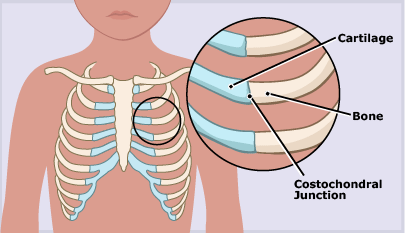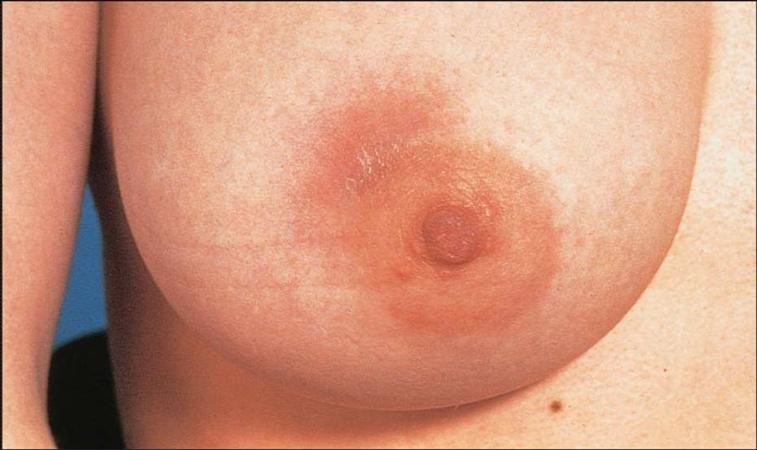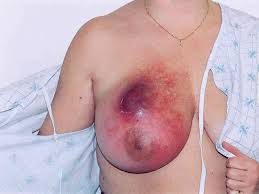Introduction:
It is a very common problem among women of age group 30-50 year (peak age 35-45 years). It usually presents as a heaviness or discomfort in the breast or as a pricking or stabbing sensation which may remain confined or radiate to adjacent areas. It may be cyclical or non-cyclical.
Causes May be:
- Hormonal (Cyclical mastalgia)
- Pregnancy (common during the first trimester)
- After childbirth (breasts may become swollen with milk and painful)
- Breastfeeding (accidental chewing by baby)
- Infection (e.g., inflammation of the breast, known as mastitis/ abscess)
- Breast lumps
- Certain drugs
- Weight gain
- Poorly fitting bras
☝If the pain occurs with following features:
- Age group is ~ 35
- Discomfort and sometimes pain (diffuse) present
- Usually bilateral but one breast may dominate
- Mainly occurs in later half of menstrual cycle (premenstrual days)
- Breasts may be diffusely nodular or lumpy
- Variable relationship to the pill
- Rare after the menopause
👇
It is Cyclical Mastalgia (It has a hormonal basis & is not harmful)
👇
🚗Visit your physician for exclusion of a diagnosis of carcinoma &
💊Management done according to the severity by Progressive step wise therapy
Step 1: Reassurance
- Proper brassiere support
- Regular review & breast self examination
- Stop smoking (if applicable)
- Diet—exclude or minimize caffeine
- Weight reduction
- Analgesics like Paracetamol
- Adjustment of oral contraceptives (if applicable)
Step 2: Addition of vitamins
- Vitamin B1 100 mg daily
- Vitamin B6 100 mg daily
Step 3: Substitute
- Evening primrose oil 1000 mg/day (Only taken after consultation with the doctor)
Step 4: Addition of
- Danazol 200 mg/d or Norethisterone 5 mg/d (Only taken after consultation with the doctor)
☝If the pain occurs with following features:
- Breast pain that does vary with menstrual cycle
- May be unilateral/bilateral & diffuse
- Continuous or intermittent
- No obvious physiological or pathological basis
👇
🚗Visit your physician for exclusion of a diagnosis of carcinoma & it is managed as
💊First-line treatment is:
- Proper brassiere support
- Regular review & breast self examination
- Stop smoking (if applicable)
- Diet—exclude or minimize caffeine
- Weight reduction
- Analgesics like paracetamol if pain present
- Adjustment of oral contraceptives (if applicable)
- Exclude caffeine from diet
- Vitamin B1 100 mg daily
- Vitamin B6 100 mg daily
💊Second-line treatment is:
- Norethisterone 5 mg/d (taken only after consultation with the doctor)
☝If the pain occurs with following features:
- Pain is acute, intermittent or chronic
- The breast is normal to palpation
- Palpable swelling ~ 4 cm from sternal edge due to enlargement of costo-chondral cartilage
- X-rays normal
- Aggravated by deep breathing and coughing
- Self-limiting, but may take several months to subside

It may be Costochondritis (Tietze’s syndrome)
👇
🚕Visit your physician for exclusion of a diagnosis of carcinoma &
💊Management is done as
- Analgesics like NSAIDs or Paracetamol given for pain
- Infiltration with LA and corticosteroid (with care & only taken after consultation of doctor)
☝If the pain occurs with following features:
- A lump and then soreness (at first)
- A red tender area
- (possibly) fever, tiredness, muscle aches and pains

👇
It may be Mastitis (inflammation of breast)
🚕Visit your physician for exclusion of a diagnosis of carcinoma &
💊Management is done as:
Treatment of systemic symptoms:
- Antibiotics: resolution without progression to an abscess will usu. be prevented by antibiotics
- Di(flu)cloxacillin 500 mg per oral four times a day for 10 days (IV if severe) or Cephalaxin 500 mg per oral four times a day for 10 days
- Aspirin or Paracetamol for pain
- Therapeutic ultrasound done
- For candida infections Fluconazole 200-400 mg per oral daily for 4 weeks, second line Nystatin 500000 U oral TDS given
Instructions to patients:
- Keep the affected breast well drained.
- Continue breastfeeding: do frequently and start with the sore side.
- Heat the sore breast before feeding (e.g. with hot shower or hot face washer).
- Cool the breast after feeding: use a cold face washer from the freezer.
- Empty the breast well: hand express if necessary.
☝If a condition develops quickly with following features:
- Florid redness, swelling, dimpling and breast heaviness.
- Not as painful as it appears—confused with mastitis but unresponsive to antibiotics.

👇
because it may be Inflammatory breast cancer (mastitis carcinomatosa)
☝If a pain develops with following features:
- If tenderness and redness persist beyond 48 h and
- An area of tense induration develops,
- Then a breast abscess has formed.
👇
Because it may be Breast abscess &
- It requires surgical drainage under general anaesthesia or
- Preferably aspiration with a large bore needle under LA every second day until resolution
- Antibiotics (e.g. dicloxacillin 500 mg per oral four times a day for 10 days)
- Rest and complete emptying of the breast
- Continue breastfeeding from the affected side or express milk if this is not possible.
Reference:
- Murtagh J, Leggat PA. John Murtagh’s General Practice Companion Handbook.
- John M. Murtaghs Patient Education. of 6th revised ed edition. North Ryde NSW: McGraw-Hill Australia. 2012
- https://cmijournal.files.wordpress.com/2016/08/23-26-mastalgia.pdf photo credit
- https://plasticsurgerykey.com/breast-pain/ photo credit
- https://www.drthindhomeopathy.com/disease/costochondritis/ photo credit
- https://step2.medbullets.com/gynecology/121861/mastitis photo credit
- https://www.memorangapp.com/flashcards/32575/Inflammatory+Breast+Cancer/ photo credit
- https://www.bmj.com/content/353/bmj.i2646 photo credit





Best pain management doctors in nj This particular is usually apparently essential and moreover outstanding truth along with for sure fair-minded and moreover admittedly useful My business is looking to find in advance designed for this specific useful stuffs…
ReplyDeleteAnything that puts pressure on or irritates this nerve can cause pain that shoots down the back of one buttock or thigh. The sensation of pain can vary widely. Sciatica may feel like a mild ache, a sharp, burning sensation, or extreme discomfort. Sciatica can also cause feelings of numbness, weakness, and tingling.https://www.leedssportsphysio.com/
ReplyDeletebest pain management near me When your website or blog goes live for the first time, it is exciting. That is until you realize no one but you and your.
ReplyDeleteIt is really a helpful blog to find some different source to add my knowledge. pain management clinic toronto
ReplyDeleteDysmenorrhea is thought to be caused by compounds in the body known as prostaglandins. Before menstruation starts each month, the level of prostaglandins in the lining of the uterus increases.
ReplyDelete